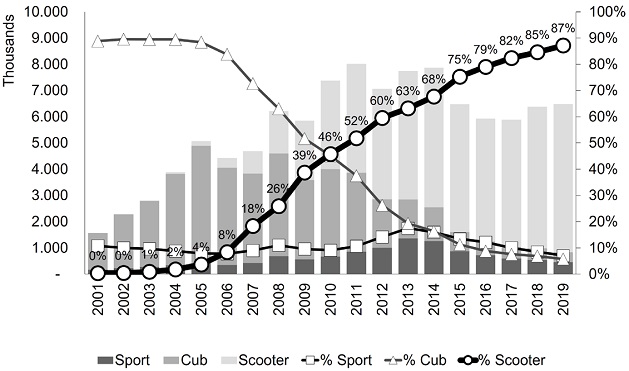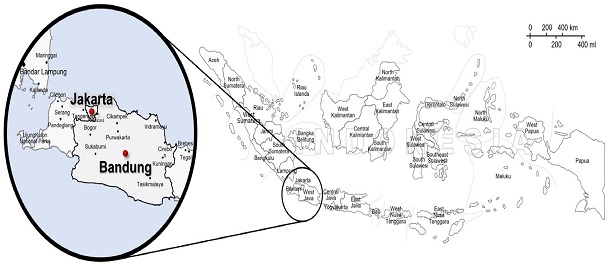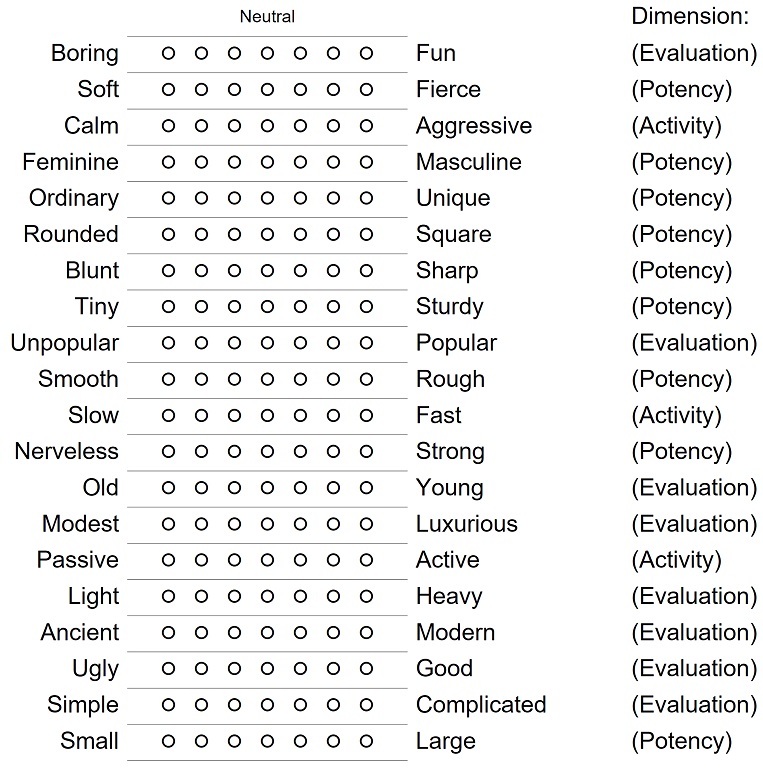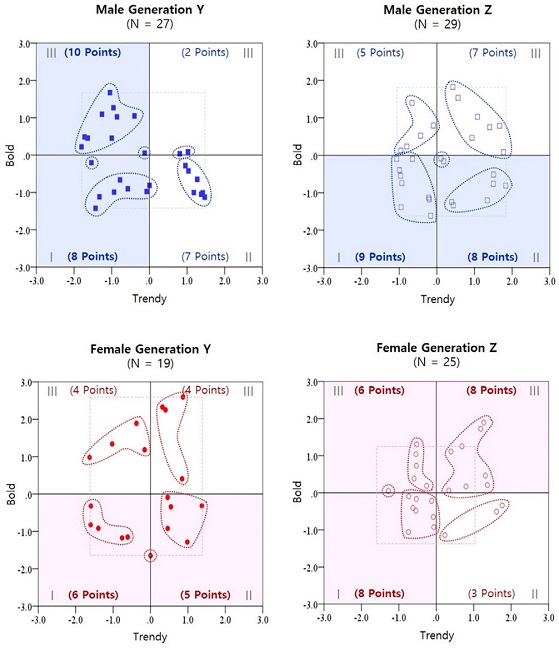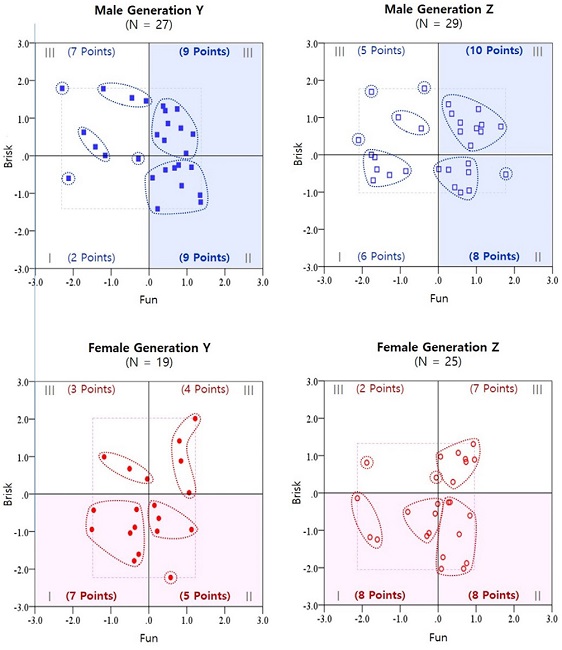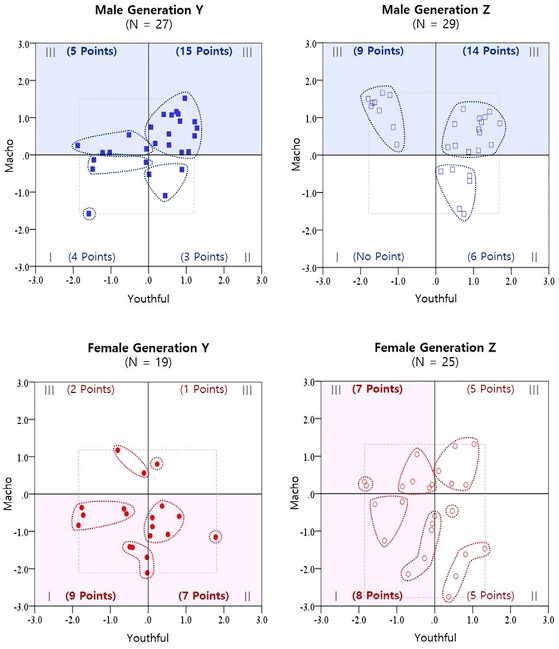
Affective Preferences of Generation Y and Z Indonesian Users towards Scooter Body Characters
Abstract
Background Amid the significant growth of the scooter market in Indonesia, investment considerations have encouraged manufacturers to market more global and regional scooter designs, which may not necessarily suit the preferences of Indonesian consumers. In light of the importance of design as an influential reason for purchasing scooters in Indonesia, this study seeks to enhance the understanding of Indonesian consumer preferences for scooter design by examining the affective preferences of gender and age group towards the design attribute of body character, which was selected as this predominantly shape the overall appearance of scooters.
Methods The semantic differential method was applied to measure the differences between genders and age groups in evaluating the design attribute of body character. The focus group discussion survey was conducted in two major cities of Jakarta and Bandung by selecting a sample of 100 scooter users from various brands and types. The collected data were processed using SPSS software. A factor analysis was performed to extract the factors with eigenvalue > 1. Two groups of factors with the highest order of weight/degree/quality were then selected, and a representative name was assigned to the factors. Subsequently, the values of the selected factors were processed into a perceptual matrix to be analysed and interpreted.
Results The ‘fashionable’ scooters (curved body shape with soft body lines) and ‘sporty’ scooters (tapered body shape with sharp body lines) are considered to represent a gender-neutral character and tend to be preferred by all genders and age groups (especially Z generation); the ‘manly’ scooters (muscular body shape with firm body lines) is considered to represent masculine character and tend to be preferred by male users (especially Y generation); the ‘elegant’ scooters (plain body shape with flowing body lines) is considered to represent feminine character and tend to be preferred by Y generation female users; however, Z generation female users dominantly prefer the gender-neutral character of ‘fashionable’ scooters over the feminine character of ‘elegant’ scooters.
Conclusions The results for user evaluation of scooter body characters are reflected in users' preferences for scooter body characters, except for Z generation females who prefer the gender-neutral characters of 'fashionable' scooters over feminine characters of 'elegant' scooters. Meanwhile, the relevant studies (especially in Taiwan) indicate that Taiwanese and Indonesian consumers have relatively different understandings of gender-neutral designs, except for the gender-neutral character of ‘fashionable’ scooters.
Keywords:
Scooter, Design Preference, Body Characters, Indonesia, Semantic Differential1. Introduction
The volume of the motorcycle market in Indonesia in 2019 reached 6,487,460 units (which makes Indonesia the third-largest motorcycle market in the world, by volume, after India and China). Among the motorcycle categories, the contribution of the scooter market grew significantly to reach 87.2% (Association of Indonesia Motorcycle Industry, 2020), as shown in Figure 1. Owing to such a large market volume and population, the scooter is presently one of the most popular modes of transportation for Indonesians. Since 2011, the scooter design trend in Indonesia has changed rapidly and the designs have become increasingly diverse. In early January 2020, at least 39 scooter models with different designs were available in the Indonesian market (almost 2.5 times more than the number of models in 2011), as shown in Figure 2. Although some scooter models were specifically designed for Indonesian consumers, investment considerations have encouraged manufacturers to market more global and regional scooter designs, which may not necessarily suit the preferences of Indonesian consumers. Under these conditions, the first impression survey of 30 respondents indicated that some scooter models were deemed less attractive by consumers, as shown in Figure 3. Because design became an influential reason in purchasing a scooter in Indonesia (Krisnanto & Utami, 2018), it leads to a reduction in the emotional satisfaction of the consumers (lowering the sense of pride in owning a scooter among the community and reducing the aesthetic experience and emotional enjoyment for its users). Furthermore, data from the Indonesian Central Bureau of Statistics (BPS) shows that generations Y and Z will become a strategic motorcycle market in the future (Indonesia Central Bureau of Statistics, 2020), as shown in Figure 4. Therefore, this research was specifically conducted to improve understanding of the preferences of Indonesian Y and Z generation users towards scooter designs, as a part of the initial process to map the optimization between the designers' design ideas and consumer design preferences.
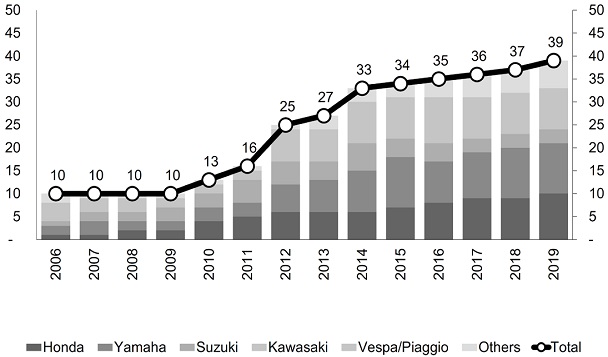
Trends in the number of scooter models based on design differencesSource: The official website of each brand (AISI members, YTD Dec 2019)
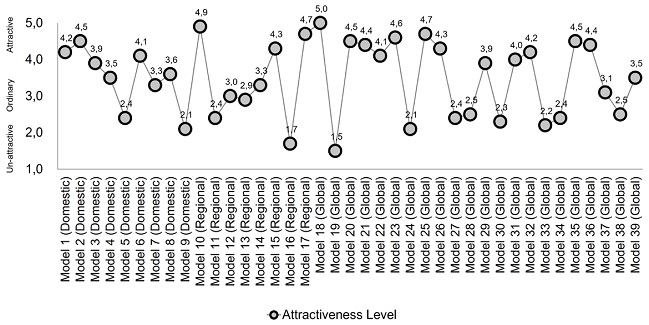
Designs’ attractiveness of each model(Based on the first impression survey of 100 respondents, November 2019)
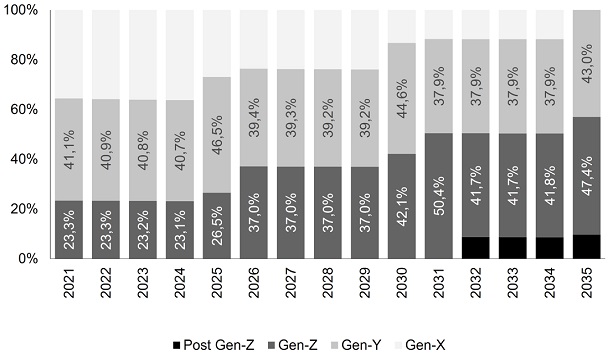
Indonesian population based on the age of motorcycle usersSource: Indonesian Central Bureau of Statistics (BPS, processed)
Extensive research has been performed, such as research on attractive factors of electric motorcycle design (Zhang, et al., 2017), consumers' preference on scooter design with gender-neutral style (Chen & Sung, 2016), assessment of factors affecting the customer preferences/purchase decision for motorcycle brands (Khoso, et al., 2016), an investigation on the gender differences of Taiwanese youths and middle-ages in evaluating motorcycle appearance and use (Yang & Chen, 2014), purchase preference of selected Malaysian motorcycle buyers (Yeong, et al., 2007), and research for style image evaluation of scooters in Taiwan and China (Kao, et al., 2003). However, none of the existing studies has been focused on exploring the consumer preferences towards scooter designs for the Indonesian market, focused on the design attribute of the body character based on gender and age group. Therefore, in this work, the authors investigate the affective preferences of generation Y and Z Indonesian users towards scooter body character.
2. Methods
2. 1. Survey location and respondents’ profile
The focus group discussion survey was conducted in Jakarta and Bandung, as shown in Figure 5. Jakarta was selected because it is the largest city in Indonesia with the most heterogeneous population characteristics (representing the culture of various ethnic groups in Indonesia), while Bandung was chosen because it is the capital city of the West Java Province with the largest motorcycle market volume in Indonesia and it is also known as a city of education, art, and technology.
A sample of 100 users possessing scooters of various brands and types were selected. The demographics of the respondents were divided by gender and age group, as shown in Table 1, where references from the Pew Research Centre were adopted to determine the age range for generation Y (Michael Dimock, 2019). Meanwhile, 17 years were used as the minimum age for generation Z, which referred to the minimum age to obtain a driving licence in Indonesia (Indonesian National Police, 2009). Furthermore, several criteria for respondents were applied, such as minimum high school education level (to ensure that some design terminology could be understood well by respondents) and those who were part of the purchasing decision-maker. In addition, references from Nielsen were adopted to classify the socioeconomic status (The Nielsen Company, 2017).
2. 2. Questionnaire
Questionnaires were administered to collect data from the respondents through a focus group discussion survey. In the survey, each respondent was shown a stimulus of each attribute and asked to respond to questions by choosing the opinion that best suits them through seven rating scales. In addition, some closed- and open-ended questions were also included in the questionnaire to support further analysis.
2. 3. Statistical analysis
The collected data were processed using the SPSS software. A factor analysis was performed to extract the factors with eigenvalue > 1 (Osgood, et al., 1978), using which, the factor loading from each evaluation item in the semantic differential could be obtained. Two groups of factors with the highest order of weight/degree/quality were then selected, and a representative name was assigned to the factors. Subsequently, the values of the selected factors were processed into a perceptual matrix to be discussed and interpreted, including determining keywords that represent the impression of each body character generated from the point of view of respondents as consumers/scooter users.
2. 4. Selecting representative design attributes, scooter models, and bipolar adjective pair for semantic differential
To determine the design attributes and scooter models as a stimulus, the exploratory method was applied, involving a comprehensive discussion with five expert designers (two designers with a work experience of 4–5 y, and three senior designers with a work experience of 14–18 y). The discussion resulted in body character, body size, and type of frame as basic attributes that predominantly shaped the overall appearance of scooters. The users’ preference for body sizes are mainly related to the purpose of use and suitability of the scooter body size to the rider's posture, whereas the users’ preference for the type of frames are mainly related to functional and emotional aspects; both require research methods involving static and dynamic riding simulations. Meanwhile, the users’ preference for body characters has more to do with the users' perception of the scooter's body shape and body lines (related to emotional/affective responses). Among the three attributes, the body character is the most influential attribute in selecting scooter design in Indonesia; therefore, it was selected as the focus attribute in this study.
Furthermore, the discussion also resulted in scooter models that were used as a stimulus for the body character, which was divided into four types (curved body shape with soft body lines, plain body shape with flowing body lines, tapered body shape with sharp body lines, and muscular body shape with firm body lines), as shown in Figure 6. The three images of each stimulus pertained to the popular scooter models in Indonesia (based on the sales volume), which were familiar to the scooter users. Moreover, all images on the stimulus were presented as monochromatic colour and side view wireframe images on a white background with the following considerations:
- (1) Respondents were not bothered by their favourite colours when they determine these answer choices;
- (2) The author wanted respondents to focus more on the body shape and body lines (not on the three-dimensional effect of the objects and other detailed attributes, such as head shape, headlight shape, headlight position, front cover shape, etc.).
To produce adjectives in the semantic differential method, the network concept approach was adopted (Nagai, et al., 2011), which generated a conceptual network (structure of associative words) with the weight of words indicated by the ODC score; extraction of bipolar adjectives for semantic differential is shown in Figure 7. Before being presented to respondents, a discussion with five expert designers and linguists was held to translate them into Indonesian and ensure that the meaning of adjectives could be understood well by Indonesian respondents, especially with the criteria of a minimum high school education level.
3. Results
3. 1. Results for the stimulus of Design A
Before determining the evaluation axis of the research object and processing the data using the semantic differential method, factor analysis was performed using the SPSS software to extract factors with eigenvalue > 1, using which, the factor loading from each evaluation item could be obtained, as shown in Table 2. The extraction and rotation were performed using the principal component analysis method and varimax method, respectively.
The table shows that five factors with different loading factors were generated. Factor F1 (λ = 3.762) represents the loading for adjectives ‘fun’, ‘masculine’, ‘unique’, ‘popular’, and ‘modern’. F2 (λ = 4.198) represents the loading for adjectives ‘fierce’, ‘aggressive’, ‘square’, ‘sharp’, ‘rough’, and ‘complicated’. F3 (λ = 2.824) corresponds to the loading for adjectives ‘sturdy’, ‘fast’, ‘heavy’, and ‘large’. F4 (λ = 2.019) corresponds to the loading for adjectives ‘strong’, ‘active’, and ‘good’. F5 (λ = 0.665) corresponds to the loading for adjective ‘luxurious’. F2 and F1 have the highest order of weight/degree/quality, followed by F2, F3, F4, and F5; therefore, to describe sufficient dimensions of perception for stimulus Design A, F1 and F2 were selected as the basis for spatial coordinate analysis or perceptual matrix. Furthermore, utilizing synonym dictionaries, a synonym analysis was carried out to assign a representative name to the factors; for example, the emotional attributes of 'fun', 'masculine', 'unique', 'popular', and 'modern' were associated with cheerful, gallant, exclusive, fashionable, or stylish and labelled as 'trendy' factors; the emotional attributes of 'fierce', 'aggressive', 'square', 'sharp', 'rough', and 'complicated' were associated with daring/bold, advancing, robust, salient, or conspicuousness and labelled as 'bold' factors, as described in Table 3.
The results of the perceptual matrix graph are presented in Figure 8. The figure shows that the perception of the dimension of Design A is different among different genders and age groups. Generation Y male users consider Design A to be ‘less trendy’ or ‘plain’, as indicated by the distribution points, which are more dominant in quadrants I and III. Furthermore, the generation Z male users and generation Y female users consider Design A to be ‘less bold’ or ‘calm’, as the distribution points are more dominant in quadrants I and II. In addition, generation Z female users consider the design to be ‘less trendy’ or ‘plain’ and ‘bold’, as the distribution points are more dominant in quadrants I, III, and IV.
3. 2. Results for the stimulus of Design B
The results of the factor analysis performed using the SPSS software to extract factors with eigenvalue > 1 were used to obtain the factor loading from each evaluation item, as shown in Table 4. The extraction and rotation were performed using the principal component analysis method and varimax method, respectively.
Six factors with different loading factors were generated. F1 (λ = 3.513) represents the loading for adjectives ‘fun’, ‘aggressive’, ‘masculine’, ‘rough’, and ‘fast’. F2 (λ = 4.198) represents the loading for adjectives ‘sturdy’, ‘strong’, ‘active’, ‘heavy’, ‘modern’, and ‘large’. F3 (λ = 2.821) corresponds to the loading for adjectives ‘popular’, ‘young’, and ‘good’. F4 (λ = 1.514) corresponds to the loading for adjectives ‘fierce’ and ‘complicated’. F5 (λ = 1.589) corresponds to the loading for adjectives ‘square’ and ‘sharp’. F6 (λ = 1.414) corresponds to the loading for adjective ‘luxurious’ and ‘heavy’. F2 and F1 have the highest order of weight/degree/quality; therefore, to describe sufficient dimensions of perception for stimulus Design B, F1 and F2 were selected as the basis for spatial coordinate analysis or perceptual matrix. Furthermore, a synonym analysis was carried out to assign a representative name to the factors; for example, the emotional attributes of ‘fun’, ‘aggressive’, ‘masculine’, ‘rough’, and ‘fast’ were associated with enjoyable, combative, brave, sharp, nimble, or electrifying and labelled as 'thrilling' factors; the emotional attributes of ‘sturdy’, ‘strong’, ‘active’, ‘heavy’, ‘modern’, and ‘large’ were associated with the firm, stable, streaming, solid, contemporary, massive, or steadiness and labelled as ‘steady’ factors, as described in Table 5.
The values corresponding to the factor analysis for F1 and F2, generated through statistical data processing, were reprocessed using the SPSS software into a perceptual matrix graph. The results of the perceptual matrix graph are presented in Figure 9. The figure shows that the different genders and age groups differently perceive the dimension of Design B, especially the male users. The generation Y male users consider Design B to have the dimensions of ‘less thrilling’ or ‘calm’ and ‘steady’, as shown through the distribution points, which are more dominant in quadrants I, III, and IV. Furthermore, generation Z male users consider the design to have dimensions of ‘thrilling’ and ‘less steady’ or ‘soft’, as shown through the distribution points, which are more dominant in quadrants I, II, and IV. All the female users consider this design to have the dimension of ‘thrilling’, as shown through the distribution points, which are more dominant in quadrants I and IV.
3. 3. Results for the stimulus of Design C
The results of the factor analysis performed using the SPSS software to extract factors with eigenvalue > 1 were used to obtain the factor loading from each evaluation item, as shown in Table 6. The extraction and rotation were performed using the principal component analysis method and varimax method, respectively.
Six factors with different loading factors are generated. F1 (λ = 4.011) represents the loading for adjectives ‘fun’, ‘unique’, ‘popular’, ‘luxurious’, and ‘modern’. F2 (λ = 2.033) represents the loading for adjectives ‘aggressive’, ‘fast’, and ‘active’. F3 (λ = 2.534) corresponds to the loading for adjectives ‘fierce’, ‘masculine’, ‘sturdy’, and ‘heavy’. F4 (λ = 1.527) corresponds to the loading for adjectives ‘strong’ and ‘large’. F5 (λ = 1.170) corresponds to the loading for adjectives ‘square’ and ‘sharp’. Meanwhile, F6 does not have an eigenvalue > 0.500. Although F3 has a higher eigenvalue (λ) than F2, F3 and F1 do not contain an activity dimension, which is a complete prerequisite for the semantic differential method (Osgood, et al., 1978); therefore, F1 and F2 were selected as the basis for the spatial coordinate analysis or perceptual matrix. Furthermore, utilizing synonym dictionaries, a synonym analysis was carried out to assign a representative name to the factors; for example, the emotional attributes of ‘fun’, ‘unique’, ‘popular’, ‘luxurious’, and ‘modern’ were associated with cheerful, fashionable, fancy, or stylish and labelled as 'fun' factors; meanwhile, the emotional attributes of ‘aggressive’, ‘fast’, and ‘active’ were associated with combative, speedy, or energetic and labelled as ‘brisk’ factors, as described in Table 7.
The values corresponding to the factor analysis for F1 and F2, generated through statistical data processing, were reprocessed using the SPSS software into a perceptual matrix graph. The results of the perceptual matrix graph are presented in Figure 10. The figure shows that only different genders perceive the dimension of Design C differently. The male users consider Design C to have a dimension of ‘fun’, as shown through the distribution points, which are more dominant in quadrants II and IV. In contrast, female users consider Design C to have the dimension of ‘less brisk’ or ‘sluggish’, as shown through the distribution points, which are more dominant in quadrants I and II.
3. 4. Results for the stimulus of Design D
The results of the factor analysis performed using the SPSS software to extract factors with eigenvalue > 1 were used to obtain the factor loading from each evaluation item, as shown in Table 8. The extraction and rotation were performed using the principal component analysis method and varimax method, respectively.
The table shows that six factors with different loading factors are generated. F1 (λ = 3.133) represents the loading for adjectives ‘fun’, ‘unique’, ‘popular’, and ‘young’. F2 (λ = 2.669) represents the loading for adjectives ‘fierce’, ‘aggressive’, ‘masculine’, and ‘strong’. F3 (λ = 2.060) corresponds to the loading for adjectives ‘sharp’, ‘rough’, and ‘complicated’. F4 (λ = 1.610) corresponds to the loading for adjectives ‘fast’ and ‘active’. F5 (λ = 1.513) corresponds to the loading for adjectives ‘good’ and ‘large’. F6 (λ = 1.197) corresponds to the loading for adjectives ‘luxurious’ and ‘heavy’. F1 and F2 have the highest order of weight/degree/quality and were selected as the basis for spatial coordinate analysis or perceptual matrix. Furthermore, a synonym analysis was carried out to assign a representative name to the factors; for example, the emotional attributes of ‘fun’, ‘unique’, ‘popular’, and ‘young’ were associated with a cheerful, different, stylish, fresh or young spirit and labelled as 'youthful' factor; the emotional attributes of ‘fierce’, ‘aggressive’, ‘masculine’, and ‘strong’ were associated with brave, combative, manly, vigorous, or masculinity and labelled as ‘macho’ factor, as described in Table 9.
The results of the perceptual matrix graph are presented in Figure 11.
The figure shows that the different genders, especially the female users, and age groups differently perceive the dimensions of Design D. All the male users consider Design D to have the dimension of ‘macho’, as shown through the distribution points, which are more dominant in quadrants III and IV. Meanwhile, the generation Y female users consider the design to have a dimension of ‘less macho’ or graceful’, as shown through the distribution points, which are more dominant in quadrants I and II, also generation Z female users consider the design to have a dimension of ‘less youthful’ or ‘old’, as shown through the distribution points, which are more dominant in quadrants I and III.
3. 5. Discussion
For more clarifications, Table 10 summarizes the results of the user evaluations regarding the body character to support the discussion.
Based on the findings, the users’ evaluation of the scooter body character can be mapped into the following groups:
- (1) Three perceptual dimensions of the body character of Design A were generated, which were dominated by the dimensions of ‘calm’ and ‘plain’, except for the generation Z females who also consider it to be ‘bold’. The 'calm' dimension reflects the specific characteristics of the feminine gender, such as feminine, gentle, tender, and warm (Bem, 1974) and the 'plain' dimension corresponds more to the neutral gender; meanwhile, the ’bold’ dimension reflects the specific characteristics of the masculine gender, such masculine, aggressive, forceful, and assertive (Bem, 1974). Because no specific dimensions exist that strongly reflect certain gender characteristics, this can be assumed that Design A represents a design with a gender-neutral character;
- (2) Four perceptual dimensions of the body character of Design B were generated, which were dominated by the dimensions of ‘thrilling’. In particular, all the female users consider Design B to be ‘thrilling’. Meanwhile, a difference exists in the dimension perception of Design B among male users; the Z generation males consider the design to be ‘thrilling’ and ‘soft’, whereas the Y generation males consider the design to be ‘calm’ and ‘steady’. The 'soft' and ‘calm’ dimensions reflect the specific characteristics of the feminine gender, such as feminine, gentle, tender, and warm (Bem, 1974), while the ‘steady’ dimension corresponds more to the neutral gender. Because 'soft' and ‘calm’ dimensions reflect the specific characteristics of the feminine gender and the ‘thrilling’ dimension reflects the emotional expression, which is specifically generated from the perception of female users, this can be assumed that Design B represents a design with a feminine character;
- (3) Two perceptual dimensions of the body character of Design C were generated, consisting of the dimensions of ‘fun’ and ‘sluggish’. In particular, all the male users consider the design to be ‘fun’, whereas all the female users consider the design to be ‘sluggish’. Because both ‘fun’ and ‘sluggish’ as dimensions do not specifically reflect certain gender characteristics, this can be assumed that Design C represents a design with gender-neutral character; and
- (4) Three perceptual dimensions of the body character of Design D were generated, which were dominated by the dimension of ‘macho’. In particular, all the male users significantly consider Design D to be ‘macho’; meanwhile, the Y generation females consider the design to be ‘graceful’, whereas the Z generation females consider the design to be ‘old’. In this case, the ‘macho’ dimension strongly reflects the specific characteristics of the masculine gender, such as masculine, aggressive, forceful, and assertive (Bem, 1974), while both ‘graceful’ and ‘old’ dimensions correspond more to the neutral gender. Because the ‘macho’ dimensions reflect the specific characteristics of the masculine gender and reflect the emotional expression, which is specifically generated from the perception of male users, this can be assumed that Design D represents a design with masculine character.
By considering the answers conveyed by the respondents as a reason to choose each stimulus, specific impression keywords for each body character can be generated, as shown in Table 11.
A synonym analysis was carried out to assign specific impression keywords for each body character; for example, the prominent reasons of ‘unique’, ‘trendy’, ‘cute’, ‘chic’, and ‘fun’ for Design A associated with the keyword ‘fashionable’; the prominent reasons of ‘elegant’, ‘simple’, and ‘luxurious’ for Design B associated with the keyword ‘elegant’; the prominent reasons of ‘sporty’, ‘cool’, ‘speedy’, ‘aerodynamic’, ‘striking’, and ‘dashing’ for Design C associated with the keyword ‘sporty’; and the prominent reasons of ‘macho’, ‘dashing’, ‘muscular’, and ‘tough’ for Design D associated with the keyword ‘manly’.
Through additional data from the responses collected to the open-ended questions in this study, the users' preference for the scooter's body character can be identified, by considering the choice of scooter body character based on gender and age group, as shown in Figure 12.
The figure indicates that the results for user evaluation of the scooter body character are relatively reflected in users' preferences for certain body characters, except for Z generation females who prefer the gender-neutral character of Design A over the feminine character of Design B. In particular, the following findings can be derived regarding the users' preference towards the scooters' body character:
- (1) Body character for Y generation usersBoth males and females from generation Y prefer Design A and D with a relatively even spread (28%), followed by Design C (24%) as the second dominant. Not completely consistent with the results for users evaluation of the scooter body character, where Design A and C represent a gender-neutral character, Figure 12 clearly shows that the preferences of both generation Y males and females towards Design D tend to be influenced by the preferences of generation Y male users who dominantly prefer the masculine character of Design D (41%) over the ‘gender-neutral’ character of Design C (26%); meanwhile generation Y female users prefer the ‘gender-neutral’ character of Design C (21%) over the masculine character of Design D (11%). Therefore, by considering these significant differences, Design A and C are the best options to attract more Y generation male and female users.
- (2) Body character for Z generation usersBoth males and females from the Z generation prefer Design A (35%) and Design C (24%) as the second dominant. This finding confirms that Designs A and C are considered to have ‘gender-neutral’ characters, which is consistent with the results for users’ evaluation of the scooter body character.
- (3) Body character for Y generation male usersA clear preference exists on how Y generation male users dominantly prefer Design D (41%). The masculine character of Design D (which also gives the impression of 'macho', 'dashing', 'muscular', and 'tough') triggers Y generation male users to choose Design D. This finding is also consistent with the results for users evaluation of the scooter body character.
- (4) Body character for Y generation female usersA clear preference also exists on how Y generation female users specifically prefer Design B (37%). The feminine character of Design B (which also gives a simple and luxurious impression) triggers Y generation female users to choose Design B. This finding is consistent with the results for users’ evaluation of the scooter body character. Moreover, Figure 12 shows that Design A also favourable for Y generation female users (32%), which can be the second alternative.
- (5) Body character for Z generation male usersSame as Y generation male users, Z generation male users also specifically prefer Design D (34%). The 'muscular body shape and firm body lines' of Design D trigger generation Z male users to choose Design D. Moreover, Figure 12 shows that Design A also favourable for Z generation male users (31%), which can be the second alternative.
- (6) Body character for Z generation female usersMore Z generation female users prefer the gender-neutral character of Design A (40%) over the feminine character of Design B (28%). Inconsistent with the results for users evaluation of the scooter body character, where Design B more represents a feminine character, Table 12 shows that the prominent reasons conveyed by Z generation female users for Design A are that they appear 'cute' (40%) and 'chic' (30%), which is significantly different from Z generation females. As a generation that tends to adapt their identity to the context (Seemiller & Grace, 2019), the 'cute' and 'chic' are are often used by Z generation females to describe female's fashion stuff, such as outfits, bags (including mini backpacks, sling bags, bucket bags, flap bags, waist bags, canteen bags), accessories, gadgets, etc. Therefore, the curvy body shape and soft body lines of Design A are considered the best representation of their daily lifestyles, such as always being active and wanting to be seen by others to get recognition for their existence (narcissistic characters).
- (7) Body character for male users A clear preference exists on how male users specifically prefer Design D (38%). The impression of 'macho', 'dashing', 'muscular', and 'tough' of Design D triggers both Y and Z generation males to choose Design D. This finding is consistent with the results for users evaluation of the scooter body character.
- (8) Body character for female usersFigure 12 shows that the preferences of female users towards Design A (36%) tend to be influenced by the inconsistency of the preferences of Z generation female users who dominantly prefer Design A (40%) over Design B (28%).
- (9) Body character for all genders and age groupsDesign A is the most preferred design character by all genders and age groups (32%), followed by Design C (24%), Design D (24%), and Design B (20%). Both males and females choose Design C and D with even spread (24%); nevertheless, Design D specifically tends to be preferred by male users (38%) over female users (7%). This finding confirms that Designs A and C are considered the most representative body characters for all genders and age groups, which is consistent with the results for users evaluation of the scooter body character.
Taking the results of a gender-neutral style study conducted in Taiwan (Chen & Sung, 2016), the optimal combination of design attributes for gender-neutral design includes the streamlined shape of the head, the rounded shape of the headlight, headlight position on the head and inclined plane, paired headlight, large size inclined plane, geometric shape of the front elevation, low type of raised tail angle, retro-looking type of style, single one colour, and high headlight coverage ratio. Among the abovementioned attributes, only the rounded shape of the headlight and the retro-looking type of style lead to the same characteristics as Design A (curved body shape with soft body lines), which are also favourable for all genders and age groups. Meanwhile, the other attributes such as headlight position on the head and inclined plane and low type of raised tail angle do not completely lead to the gender-neutral characteristics in this study; for example, the headlight position of some models on the stimulus Design A and C are on the head while others are on the inclined plane, but none are on both head and the inclined plane at the same time. These findings indicate that in addition to the ‘fashionable’ characters, Taiwanese and Indonesian consumers have different understandings of gender-neutral designs.
In addition, the results of an investigation on the gender differences of Taiwanese youths and middle ages in evaluating motorcycle appearance and use conducted in Taiwan (Yang & Chen, 2014) indicated that males tend to prefer 125-150cc sports styles, which make people feel expensive, steady, and firm. Meanwhile, females tend to prefer the compact shape of 100-115cc models, which are easy to operate, comfortable, as well as express softness and femininity. In addition, the results also specifically mention that complex and sharp shapes are suitable for males, while small volume and natural looks of the simple curves are suitable for females. Apart from the influence of engine capacity and body size on scooter design preferences in Taiwan, the complex and sharp shapes lead to the same characteristics as Design C (tapered body shape with sharp body lines). Meanwhile, the curved designs lead to the same characteristics as Design A (curved body shape with soft body lines). Both of which are favoured by Indonesian consumers from all genders and age groups. Therefore, these findings indicate that Taiwanese and Indonesian consumers have relatively different understandings of gender-neutral designs.
Furthermore, the results of research on attractive factors of electric motorcycle design (Zhang, et al., 2017) conducted in China indicated that if the ‘straight-line shape with sharp angle’ could be applied in the design of the front face, the appearance of the motorcycle would approach to the Kansei word ‘strong’ and the ‘front shape of the plump curve’ most approaches to the Kansei word ‘soft’. Although these results do not directly lead to specific scooter design preferences based on gender and age group, the same associations are given for certain characters, such as 'front shape of plump curve' also perceived as 'soft'. However, 'straight-line shape with sharp angle' is perceived as 'strong', while in Indonesia the character is perceived as 'sporty' which is associated with the impression of 'speedy', 'aerodynamic', 'striking', and 'dashing'.
Subsequently, the results of the assessment of factors affecting the customer preferences/purchase decision for motorcycle brands (Khoso, et al., 2016) conducted in Hyderabad, India, indicated that both external factors (price affordability, quality, mileage, maintenance cost, style, and other attributes) and internal factors (family, brand perception, friends and peer advice, word of mouth, occupation, and previous experience) influence individual’s decision to buy a particular brand motorcycle. Among them, the external factors of price, quality, and style are the major factors that influence an individual’s decision of buying a particular brand motorcycle. Similar to Indonesia, these results confirm the important role of design as one of the main factors that consumers consider before buying a motorcycle, including a scooter.
Moreover, the results of research for style image evaluation of scooter in Taiwan and China – a comparative study on formation elements and image analysis of scooter (Kao, et al., 2003) indicated that, for Taiwan, the 'sporty' was described by ‘a moving front fender’, which gives the impression of mechanical, high performance, and speedy; the 'stylish' was described by ‘headlights on the head’ and ‘turn signal lights on the front cover’, which gives the impression of being simple and easy to operate; the 'utility' was described by ‘integrated front fenders and front panels’ and ‘longer body’, which gives the impression of majestic, functional and practical. Meanwhile, for China, the 'smart' was described by ‘a compact body’ and ‘headlights position on the head’, which gives the impression of functional and intelligence; the 'family' was described by ‘non-integrated turn signals’ and ‘soft front and side headlights’; the 'utility' was described by ‘integrated front fenders and front panels’ and ‘longer body’, which gives the impression of majestic and robust; the 'casual' was described by 'a movable front fender' and 'a compact body', which gives the impression of being easy to ride. Although (especially for Taiwan), some impressions show the closeness of meaning to the reasons for choosing certain characters in this study (such as 'fast' impression appears for 'sporty' characters and 'simple' impression appears for 'stylish' characters), none of the attributes mentioned above shows the same characteristics as the results of this study; for example ‘a moving front fender’, ‘headlights on the head’, and ‘turn signal lights on the front cover'.
4. Conclusion
4. 1. The result of the study
As the most popular mode of transportation for Indonesian, scooters are used for various purposes. Some people use scooters to support their daily activities (such as going to school/workplace, picking up family, daily shopping, etc.), for which the consideration of functional aspects is dominant; meanwhile, others use scooters to support their lifestyle/hobbies (such as hanging out in cafes/coffee shops/restaurants, touring with clubs/communities, going to recreational areas, etc.), in which case, the consideration of emotional aspects plays an important role. In this context, because, in reality, the two roles are often correlated (76% of respondents use scooters both for daily activities and support their lifestyle/hobbies), the users’ emotional/affective responses need to be considered. Therefore, before designing or importing scooters for the Indonesian market, it is important to tailor the product to the preferences of generation Y and Z Indonesian users towards the scooter body character, or at least not taking the opposite design direction. In particular, the results of this study indicate that the user evaluation of scooter body characters is reflected in users' preferences for scooter body characters, except for Z generation females who prefer the gender-neutral characters of 'fashionable' scooters over feminine characters of 'elegant' scooters. Meanwhile, the relevant studies (especially in Taiwan) indicate that Taiwanese and Indonesian consumers have relatively different understandings of gender-neutral designs, except for the ‘gender-neutral’ character of ‘fashionable’ scooters.
4. 2. Practical Implications
Owing to such a large scooter market volume in Indonesia, it will be attractive for manufacturers to tailor their production to the specific taste of the population; however, in a globalized mobility market, it also may not be cost-effective to adapt a vehicle design to a particular country unless it offers a very high commercial advantage over competitors. Therefore, these practical implications are intended as an invitation for manufacturers or marketers in Indonesia to adapt their scooter models as much as possible to the design preferences of Indonesian consumers (including when they want to import regional and global models). The following findings can be derived as initial references by the automotive designers and manufacturers in Indonesia:
- (1) In developing or importing a scooter design to attract more Y and Z generations (both males and females), specific requirements such as curved body shapes with soft body lines need to be considered; in addition, tapered body shapes with sharp body lines can also be the second alternative;
- (2) In developing or importing a scooter to specifically attract more male users (both Y and Z generations), specific requirements such as muscular body shapes with firm body lines need to be considered; in addition, curved body shapes with soft body lines are also favourable for them (especially the Z generation);
- (3) In developing or importing a scooter to specifically attract more female users (both Y and Z generations), specific requirements such as curved body shapes with soft body lines need to be considered; in addition, plain body shapes with flowing body lines are also favourable for them (especially the Y generation);
- (4) In developing or importing a scooter design to attract all genders and age groups, specific requirements such as curved body shapes with soft body lines need to be considered; In addition, tapered body shapes with sharp body lines are also favourable for them (can be the second alternative).
4. 3. Limitations and suggestions for further research
As a part of the initial process to map the optimization between the designers' design ideas and consumer design preferences, further studies are still needed to obtain a more comprehensive understanding regarding the preferences of Indonesian consumers towards scooter design. Therefore, the author would like to take this opportunity to convey acknowledgment of certain limitations of this study that need to be discussed, such as the limitation in sampling, where the result still does not fully represent the whole generation Y and Z population of Indonesia (including the composition of education level, occupation, and social-economic status) so that it has the potential to be biased in some aspects; the multicultural nature of Indonesia's population (with over 300 ethnic groups), so that the research has yet to offer much in the form of actionable insights into the design of culturally appropriate scooter design; and limitations in the discussion which still does not yet come close to how consumers experience the product in real life, in context (real environment, real use), and at a scale to which they can relate physically.
To obtain more comprehensive findings regarding scooter designs that represent the consumer design tastes throughout Indonesia, further research needs to be conducted in the following respects:
- (1) Expanding the coverage of respondents, such as sampling represents the whole generation Y and Z population of Indonesia (including the education level, occupation, and social-economic class), sampling based on the contribution of sales or the number of population in each region and represent urban, suburban, and rural areas; thus enables the researchers to generalize the findings;
- (2) Expanding the research from a cultural perspective, such as the meaning, values, and norms of the Indonesian people (including the specific cultures of the various ethnic groups);
- (3) Expanding the research based on "real life" product experiences and usage patterns (such as the purpose of use, mileage, average speed, tandem habit, etc.) could point to the need for more gender-inclusive and culturally appropriate scooter designs;
- (4) Further research to evaluate the variations in the user adoption of body size and frame type as the design attributes that predominantly shape the overall appearance of scooters;
- (5) Further investigations focusing on the detailed design attributes that may possibly influence the impression of ‘emotional novelty’ and reflect local culture and tradition, including the colour and stripe preferences, textures, patterns, or other forms of customization.
Notes
Copyright : This is an Open Access article distributed under the terms of the Creative Commons Attribution Non-Commercial License (http://creativecommons.org/licenses/by-nc/3.0/), which permits unrestricted educational and non-commercial use, provided the original work is properly cited.
References
- Association of Indonesia Motorcycle Industry. (2020). Statistic distribution. Retrieved from https://www.aisi.or.id/statistik.
-
Bem, S. L. (1974). The Measurement of Psychological Androgyny. Journal of Consulting and Clinical Psychology, 42(2), 155-162.
[https://doi.org/10.1037/h0036215]

- Chen, C. C., & Sung, I. J. (2016). Consumers' Preference on Scooter Design with Gender Neutral Style. Journal of Engineering and Applied Sciences, 11(18), 10966-10970.
- Dimock, M. (2019). Defining generations: where millennials end and generation Z begins. Retrieved from https://www.pewresearch.org/fact-tank/2019/01/17/where-millennials-end-and-generation-z-begins.
- Indonesian Central Bureau of Statistics. (2020). Indonesia population projection 2010-2035. Retrieved from https://www.bps.go.id/publication/2013/10/07/053d25bed2e4d62aab3346ec/proyeksi-penduduk-indonesia-2010-2035.html.
- Indonesian National Police. (2009). Regulation of the head of the national police of the Republic of Indonesia number 9 of 2012, concerning driving license, article 25. Retrieved from https://peraturan.go.id/peraturan/index-lembaga.html.
- Kao, J., Kamaike, M., & Nagao, T. (2003). Research for Style Image Evaluation of Scooters in Taiwan and China: A Comparative Study on Formation Elements and Image Analysis of Scooters. Proceedings of the 49th Annual Conference of JSSD (53-60), Wakayama, JSSD.
- Khoso, A. A., Kazi, A. S., Ahmedani, M. M., Ahmed, M., & Memon, M. O. (2016). Assessment of Factors Affecting the Customer Preferences/Purchase Decision for Motorcycle Brands: An Analysis of the Motorcycle Users of Hyderabad. International Journal of Multidisciplinary Research and Development, 3(6), 239-247.
-
Krisnanto, U., & Utami, W. R. (2018). Gender Interview on Functional Design, Hedonist, Symbolic Benefits for Motorcycle Buying Decision. Business and Management Studies, 4(2), 17-23.
[https://doi.org/10.11114/bms.v4i2.3082]

-
Nagai, Y., Georgiev, G. V., & Zhou, F. (2011). A Methodology to Analyse In-depth Impressions of Design on the Basis of Concept Networks. Journal of Design Research, 9(1), 44-64.
[https://doi.org/10.1504/JDR.2011.039617]

- Nielsen Company. (2017). Nielsen's new approach for Indonesia's socio-economic status. Retrieved from https://www.scribd.com/document/365564356/Nielsen-New-Approach-for-Indonesia-Socio-Economic-Status-to-Share.
- Osgood, C. E., Suci, G. J., & Tannenbaum, P. H. (1978). Measurement of meaning. USA: University of Illinois Press.
-
Seemiller, C., & Grace, M. (2019). Generation Z, a century in the making. Routledge, Taylor and Francis Group, London-New York.
[https://doi.org/10.4324/9780429442476]

- Yang, C., & Chen, C. S. (2014). An Investigation on the Gender Differences of Taiwanese Youths and Middle-ages in Evaluating Motorcycle Appearance and Use. Proceedings of the Kansei Engineering and Emotion Research International Conference (405-422), Linköping, Linköping University.
- Zhang, Z., Ding, W., Cheng, J., Ye, J., & Li, T. (2017). Research on Attractive Factors of Electric Motorcycle Design. Proceedings of the 24th ISPE Inc. International Conference on Trans-disciplinary Engineering (269-275), Singapore, IOS Press BV.
